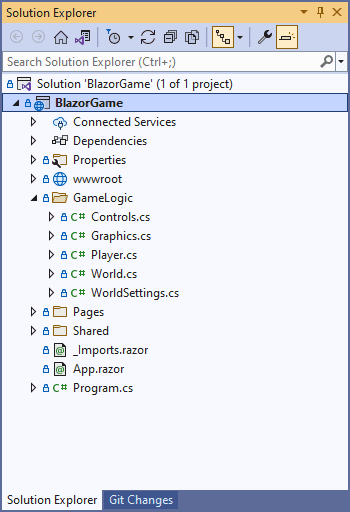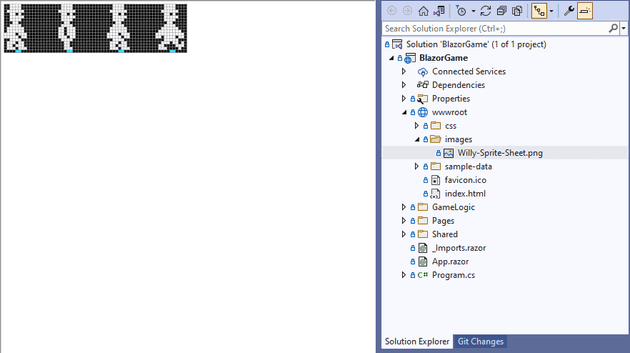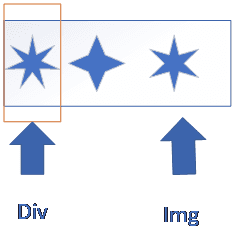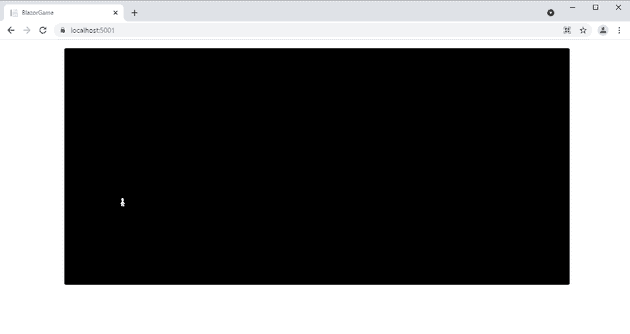In this post I started writing a game in Blazor. In this last post, I covered how we could use the keyboard to move an object around, and how we could apply gravity.
In this post, we’re going to refactor, and we’re going to replace the word test with something approximating Willy.
Refactor
Just because we’re writing a game in Blazor is no reason not to use the IoC container in order to better structure the code. I’m not going to cover all of the refactoring here; however, the changes are here.
We’ve added a sub-directory called GameLogic which contains all the relevant classes:
At some point in the future, we may separate this directory into its own project; but for now, we have four classes:
Controls - this handles the user input.
Graphics - this will handle the manipulation of the graphics.
Player - this handles behaviour of the player.
World - this deals with the things such as collisions, gravity, etc.
WorldSettings - these are just a list of variables that control how things move. In the original game, there was a POKE that meant you could jump so high that you went into the next room.
I won’t cover what’s actually in these classes - it’s essentially what was in the main Razor file. I will cover the change to the razor file itself:
@page "/"
@using System.Timers
@using BlazorGame.GameLogic
@inject IPlayer Player
@inject IControls Controls
@inject IWorld World
<div @onkeydown="HandleKeyDown" @onkeyup="HandleKeyUp" @onkeydown:preventDefault
style="background-color: #000000; width: 80vw; height: 80vh; margin: auto"
tabindex="0" @ref="mainDiv">
<div style="color: white; top: @(Player.Top)px; left: @(Player.Left)px; width: 20px; position: relative">test</div>
</div>
@code {
private ElementReference mainDiv;
private Timer \_timer;
private void HandleKeyUp(KeyboardEventArgs e) =>
Controls.KeyUp(e.Code);
private void HandleKeyDown(KeyboardEventArgs e) =>
Controls.KeyDown(e.Code);
protected override async Task OnAfterRenderAsync(bool firstRender)
{
if (firstRender)
{
await mainDiv.FocusAsync();
}
}
protected override Task OnInitializedAsync()
{
\_timer = new Timer();
\_timer.Interval = 16;
\_timer.Elapsed += TimerElapsed;
\_timer.AutoReset = true;
\_timer.Enabled = true;
return base.OnInitializedAsync();
}
private void TimerElapsed(Object source, System.Timers.ElapsedEventArgs e)
{
Update();
Draw();
}
private void Update()
{
World.ApplyPhysics();
}
private void Draw() =>
this.StateHasChanged();
}
This is much more terse than before, and delegates most of its functionality to the classes that we described above. You’ll see at the top that we @inject those classes into the page.
Finally, the classes are registered in Program.cs:
public static async Task Main(string[] args)
{
var builder = WebAssemblyHostBuilder.CreateDefault(args);
builder.RootComponents.Add<App>("#app");
builder.Services.AddScoped(sp => new HttpClient { BaseAddress = new Uri(builder.HostEnvironment.BaseAddress) });
builder.Services.AddSingleton<IWorld, World>();
builder.Services.AddSingleton<IPlayer, Player>();
builder.Services.AddSingleton<IControls, Controls>();
await builder.Build().RunAsync();
}
This is by no means the last refactoring that we’ll do, but it’s perhaps the last one that will make it into its own section of a post.
Graphics
For the graphics, I spent a while trying to get various graphics libraries to work cross platform. I finally realised that, not only did I not need a graphics library, but that I’d solved this issue before - well, more or less. The answer was to use CSS to animate the image. The very first step was to add a sprite sheet; which I got from here, and since Jet Set Willy is the same character as manic miner (with just one pixel difference in the hat), I managed to add a sprite sheet:
The next change was to alter the HTML in Game.razor slightly:
<div @onkeydown="HandleKeyDown" @onkeyup="HandleKeyUp" @onkeydown:preventDefault
style="background-color: #000000; width: 80vw; height: 80vh; margin: auto"
tabindex="0" @ref="mainDiv">
<div style="color: white; top: @(Player.Top)px; left: @(Player.Left)px; width: 16px; height: 17px; overflow: hidden; position: relative">
<img
src="/images/Willy-Sprite-Sheet.png"
style="margin: 0 @(Graphics.PlayerOffset)px; transform: scaleX(@(Graphics.PlayerDirection))" />
</div>
</div>
There’s a few things to unpick here. Let’s start with the interaction between the div and the img. Essentially, we’re using the div as a window into the image; similar to this:
Both the margin and transform are set to bound properties of a new Graphics class, which we’ll come to in a second; but first, let’s see the other change to this file:
private void Update()
{
World.ApplyPhysics();
if (Player.IsWalking)
{
Graphics.CyclePlayer();
}
}
This allows us to change the bound variables that we mentioned earlier.
Now that we’ve seen the changes to the main razor file, let’s see the new Graphics class:
public class Graphics : IGraphics
{
private readonly IPlayer \_player;
private int \_playerOffset = 0;
private DateTime \_lastUpdate = DateTime.MinValue;
public Graphics(IPlayer player)
{
\_player = player;
}
public int PlayerOffset => \_playerOffset;
public int PlayerDirection =>
\_player switch
{
{ IsWalkingLeft: true } => -1,
{ IsWalkingRight: true } => 1,
\_ => 0
};
public void CyclePlayer()
{
if (\_lastUpdate.AddMilliseconds(100) > DateTime.Now) return;
if (\_playerOffset > -48)
\_playerOffset -= 16;
else
\_playerOffset = 0;
\_lastUpdate = DateTime.Now;
}
}
This is essentially a utility, or helper class. It encapsulates details about the graphics that are displayed, and uses the Player class to do so. Most of it is relatively self-explanatory, with the possible exception of CyclePlayer which moves the offset that we mentioned earlier no more frequently that every 100ms.
That’s pretty much it; we now have a walking Willy:
What’s Next?
In the next post, we’ll try to add a platform, and some collision logic.
References
https://www.spriters-resource.com/fullview/113060/
https://gunnarpeipman.com/csharp-reading-embedded-files/
https://www.hanselman.com/blog/how-do-you-use-systemdrawing-in-net-core
https://www.davidguida.net/blazor-gamedev-part-11-improved-assets-loading/
https://stackoverflow.com/questions/493296/css-display-an-image-resized-and-cropped



